The Grape has many health benefits, varieties, and nutritional value of Grapefruits. Grapes are true berries. The fruit wall is fleshy throughout. Fruit can be green, red, and deep purple. A Grape crop is a deciduous woody vine belonging to the flowering plant genus Vitis. The Grape plant is a perennial bush featuring helices–tendrils, and trails.
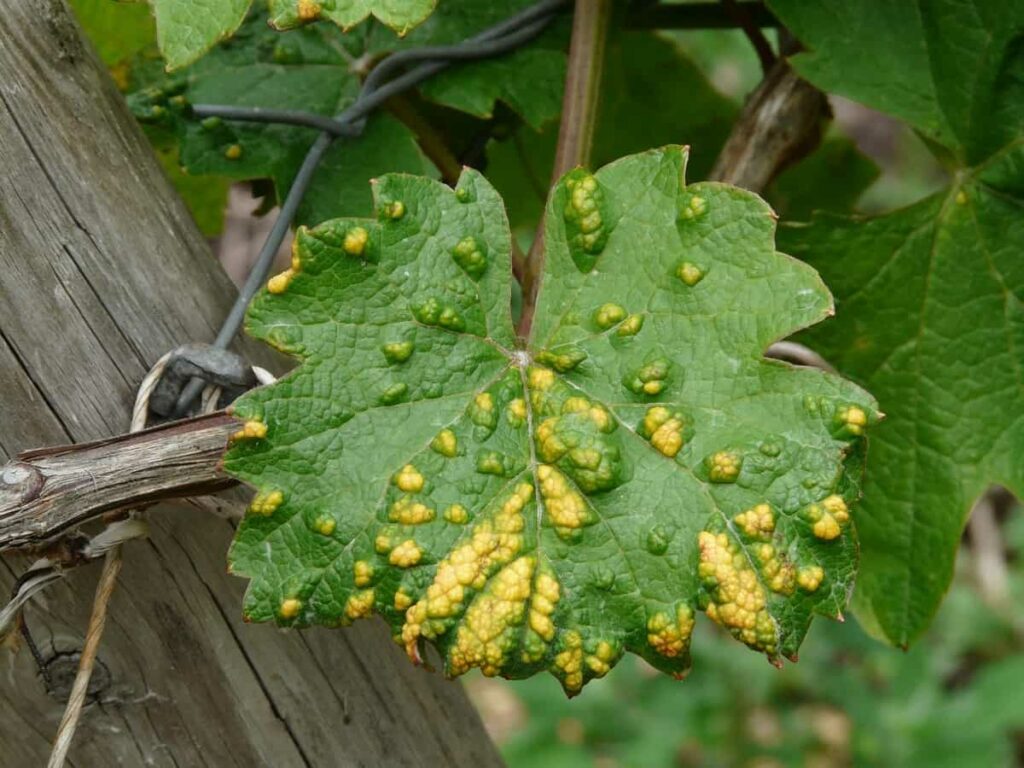
The tendrils, which are degenerated inflorescences, grow on stems. Leaves are shaped like big hearts and placed opposite each other. They show prominent nerves. The color, size, and shape of leaves and fruits vary with the variety. There are seedless and seeded varieties.
How to control pests and diseases in Grapes
Pests in Grape cultivation
As many as 100 insects and mite pests have been reported to damage various parts of Grapevine from different Grape-growing states of India. Of these, only 15-20 species are considered to cause serious losses if adequate and timely preventive and curative measures are not taken.
Among them, thrips, mealy bugs, stem borers, mites, flea beetle, and leaf and bunch-eating caterpillars are important occurring year after year. In contrast, other pests like leaf roller, chafer beetles, stem girdlers, and leafhoppers occur infrequently and are less important. As much as 80% economic yield loss is reported on Grapes due to pests in India.
Mealy Bugs
The mealybug is a soft insect with an oval-shaped flat body. The nymphs of mealy bugs, commonly known as crawlers, are pink to light orange. In June-August, they become active, and in November-March, they cease to be active. As mealy bugs secrete droplets, a heavy black sooty mold may develop on honeydew. In addition, the fruit set is affected if the flower blooms are attacked. Mealybugs can cover the fruits completely when they are infested.
Damage symptoms
- Nymphs and adult mealybugs suck the sap from the trunk cordons, buds, spurs, aerial roots, leaves, shoots, nodes, flower panicles, and bunches.
- Infestation of the growing point, especially with the pink mealybug, results in malformation of leaves. In addition, this pest attack weakens the grownup vines.
- Young vines often die from severe mealybug infestations.
- Fruits may drop from the plants or remain on the shoots, dried and withered due to infestation.
Biological control
- One of the most effective predators of Planococcus citri is Cryptolaemus montrouzieri Muls., which was introduced into the Black Sea coastal area from Egypt.
- In addition, various species of ants feed on the honeydew. Ants drive away their natural enemies and act as carriers of bugs.
In case you missed it: How to Start Grapes Farming in the USA: Production, and A Step-by-Step Growing Guide for Beginners
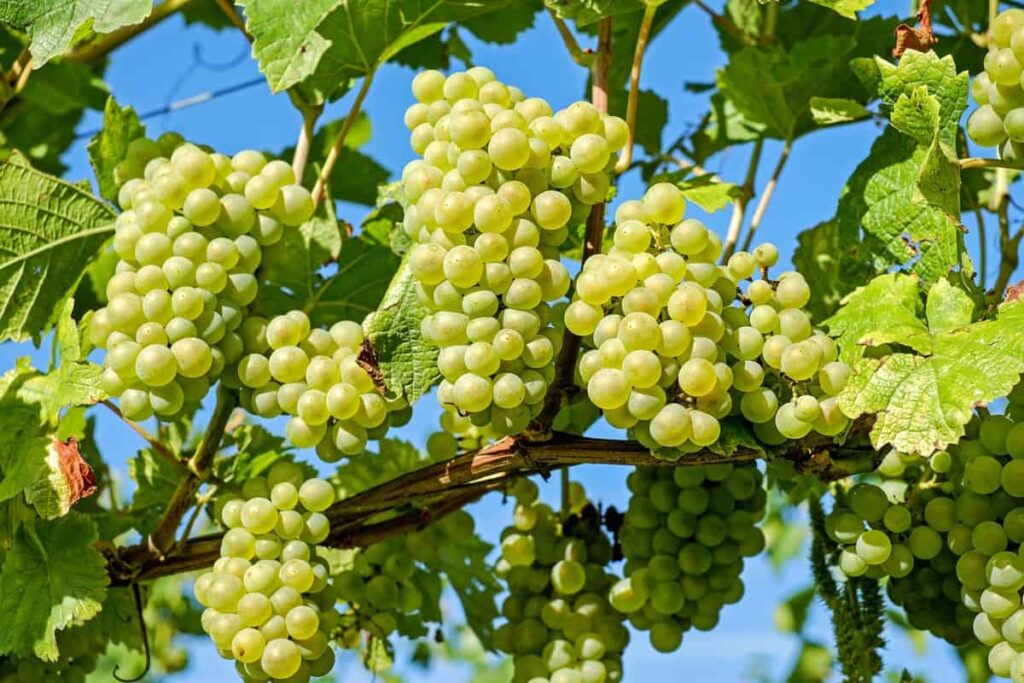
Chemical control
- Mealybugs on plants can be effectively removed with neem oil, a natural pest control product. In addition to killing bugs, it also prevents residual pest problems.
- Depending on the incidence of mealybugs and harvest time, if necessary, one or two applications of dichlorvos (76% EC 2 ml/liter) should be made between mid-February and the first week of March.
- One jet spray of water can be given on the bunches if the mealybugs are still present just before harvest to dislodge the mealybugs.
Grape leaf folder
Grape leaf folder is a severe pest in South India, most active in August-November. Grape leaf folders are almost black, with white spots on the forewings and two white stripes across the abdomen. Grape leaf folders have three generations a year (about April-May, June 15-July 15, and August). After overwintering as pupae, moths emerge in April or May, laying flat, elliptical eggs singly on the leaf’s upper or lower surface.
Damage symptoms
- Once the larva is large enough, it folds the leaf, exposing the underside; silk threads hold the edge in place.
- By feeding within this fold, the larva skeletonizes the upper surface of the leaf.
- Even at a considerable distance, the damage to the vine becomes obvious when the larvae are numerous.
- Further, the light undersurface of the folded leaves contrasts starkly with the dark green top surface, giving the vine a patchy appearance.
- The larvae roll the thin leaves of muscadine vines.
Biological Control
- Parasitism by this parasite frequently reduces second and third-generation populations to below economic levels. In addition, generalist predators such as lacewings and spiders also attack Grape leaf folder larvae.
- And also release larval parasitoids like Bracon cushmani, Cardiochiles spp
- Biological control and sprays of Bacillus thuringiensis and the Entrust formulation of spinosad are organically acceptable methods.
Chemical control
- Products containing the active ingredients chlorpyrifos, emamectin, indoxacarb, or metoxifenocid can be sprayed on time to control populations
- A simple practice to control the pest population is to collect and burn the infested leaves. In addition, spraying of Malathion (0.05%) or Endosulphan (0.05%) has also been recommended to control the pest effectively.
Flea beetles
It is a dark metallic greenish-blue jumping beetle about 1/5 inch long; its larvae are brownish with black spots, and its eggs are pale yellow. Adults eat buds and unfolding leaves, producing hollowed leaves that emerge ragged and tattered. Larvae feed on flower clusters and skeletonize leaves like adult rootworm feeding. These are often the first insect pests to begin attacking Grapes. Damaged buds will not develop into primary canes, which can reduce yields.
In case you missed it: Growing Grapes In Greenhouse – Farming, Cultivation, Production In India
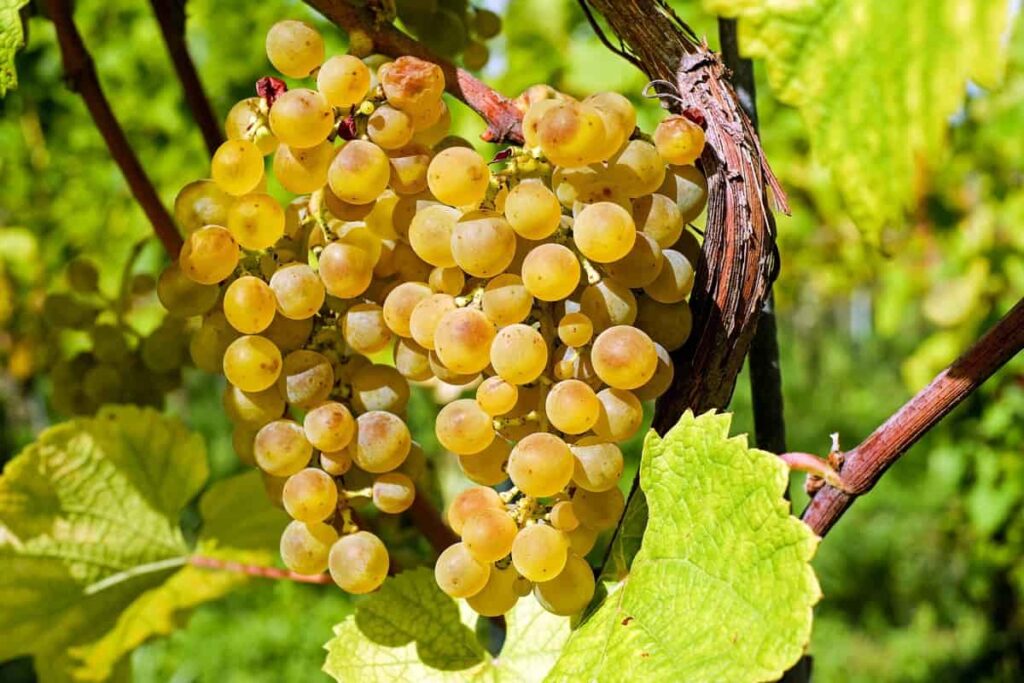
Damage symptoms
- Damaged buds fail to sprout. Instead, the beetles feed on tender shoots, leaves, and tendrils, causing substantial damage.
- After each pruning, adult beetles scrape the sprouting buds. Withering and dropping of tender shoots may occur. After forward pruning, the sprouting buds are damaged, resulting in heavy losses.
- Beetles feed on primary buds, preventing them from developing into shoots, resulting in a lower yield.
Biological control
- The predatory bug, the blue bug, is the primary biological control vector of the vine flea beetle.
- However, other predators and polyphagous parasites can also be used to control the pest. In addition, beneficial nematodes applied to the soil will destroy the larvae and help to prevent the next generation of adults from emerging.
- Spinosad, or neem oil formulations applied by spraying after observing the first adults, can also help to control the populations.
Chemical Control
- Biological treatments and preventive measures should always be considered in an integrated approach. For example, active substances recommended against the vine flea beetle include chlorpyrifos and cyhalothrin formulations that should be applied by spraying or dusting after observing the first adults.
- The application of Broflanilide 300 GL SC can also effectively control flea beetles.
Mites
Both European red mites and two-spotted spider mites can cause injury to Grapes. Both feed on the undersides of the leaves, and when populations are high, they will cause “bronzing” of the foliage. The European red mite overwinters as eggs laid around the cane nodes, while the two-spotted spider mite female adults overwinter under the bark of Grapevines. These mites significantly reduce the yield and crop quality.
Damage symptoms
- The nymphs and adults sucking the sap from tender leaves cause the cells to collapse and die.
- The mites remove chlorophyll up to 70% in heavy infestations, leading to brown burnt patches on the leaves that wither and eventually die.
- The discoloration of leaves reduces photosynthesis, affecting the plant’s vigor.
- Spider mite infestations delay maturing and ripening of Grape bunches and reduce sugar content, affecting Grape quality.
Biological control
- Release predatory mites, predatory beetles such as small staphilinids, ladybird beetle, lacewing, predatory thrips, anthocorid bug, mirid bugs
- Different neem formulations containing azadirachtin, depending upon the strength of the botanical, viz., 1% at 2.0 ml and 5% at 0.5 ml per liter, can be sprayed
Chemical control
Chemical Control Effective management of mites on Grapes relies primarily on using chemicals. Therefore, the time of application is crucial in the management of mites. Thus, the first application should be made to the appearance of mites.
In case you missed it: Pests and Diseases Management in Cotton: Causes, Symptoms, Chemical, and Biological Control
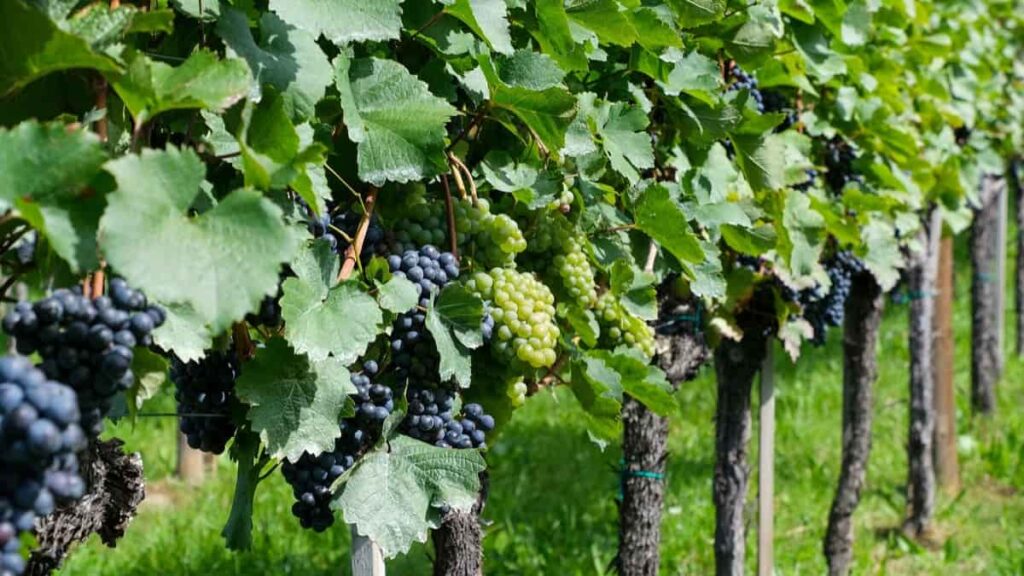
| Insecticide | Dose (per liter) |
| Dicofol 18.5 EC | 2.50 ml |
| Fenpyroximate 5 SC | 1.00 ml |
| Difenthurion 50 SC | 0.80 ml |
| Sulfur 80 WP | 2.00 gm |
| Abamectin 1.9 EC | 0.30 ml |
| Azadirachtin 1% | 2.00 ml |
Thrips
Thrips are oval, black-colored tiny insects that deposit eggs on the underside of the leaves. Both the nymphs and adults suck the cell sap from the lower surface of the leaf. The injured surface is marked by several minute spots, producing a silvery-speckled effect, which can be detected from a distance. Thrips also attack blossoms and newly set berries. The affected berries develop a corky layer and become brown on maturity. As a result, fruit setting is poor, and yield is considerably reduced.
Symptoms
- Nymphs and adults cause damage both by rasping the lower surface of the leaf with their stylets and sucking the oozing cell sap.
- The injured surface is marked by the number of minute spots, producing a silvery-speckled effect.
- Curling of the leaves is observed in case of heavy incidence.
- The thrips also attack blossoms and develop berries.
Biological control
- Several predators, including minute pirate bugs, undoubtedly play a role in controlling thrips in vineyards.
- The green lacewing Chrysoperla carnea is commonly associated predator with insect pests in the vineyards.
Chemical control
- Spray Dimethoate 0.06% at late flowering, followed by Acephate 0.1125% to control the pest.
- Scirtothrips dorsalis has a similar occurrence and mode of damage as the above species and is controlled by two sprays of Monocrotophos 0.05% or Acephate 0.1125% at ten days intervals.
- Spraying fungal pathogens, namely Verticillium lecanii or Beauveria bassiana, at 5 ml or five grams per liter, helps reduce thrips population in cold and humid climates, especially in temperatures between 20-25°C and humidity of above 80%.
Diseases in Grape cultivation
Preventing serious outbreaks of diseases and losses in yield and quality in the vineyard requires rapid, accurate identification. Despite this, the presence of a pathogen or disease does not necessarily indicate the need for treatment. Furthermore, the severity of diseases varies yearly, depending primarily on weather conditions. Below are some common diseases occurring in Grape cultivation and their control methods.
Powdery mildew
This fungus attacks several related species of Grape plants. It is, however, the most widespread disease of Grapevines. Powdery mildew is susceptible to different types of wine Grapes. The powdery mildew is the most persistent fungus that affects Grapes. Grapevine fungus is one of the most prevalent fungal diseases worldwide. A dark gray to white powdery growth is seen on the vine’s green tissue caused by the fungal pathogen Erysiphe necator. Both table Grapes and wine Grapes are affected by it.
Disease symptoms
- There is a possibility that it will infect all green tissues of the Grape.
- Throughout the growing season, tissues are generally susceptible to infection.
- The leaves of diseased plants appear whitish gray, dusty, or powdery white. In addition, petioles, cluster stems, and green shoots often look distorted or stunted.
- The sugar content of berries can be infected to about 8%.
Chemical control and management
- For organic Grapes, Serenade and Regalia can control the disease through microbial antagonism and induced resistance, respectively.
- Increase the effectiveness and longevity of these products by adding a spreader sticker. Furthermore, mineral oils and potassium bicarbonate salts can eradicate visible powdery mildew colonies.
- Oxidate (hydrogen peroxide) is also an eradicant but dissipates rapidly. Eradicants should be sprayed thoroughly (use sufficient spray volume), as only colonies contacted by the fungicide will die.
In case you missed it: Okra Pests, Diseases, Symptoms, And Control Measures
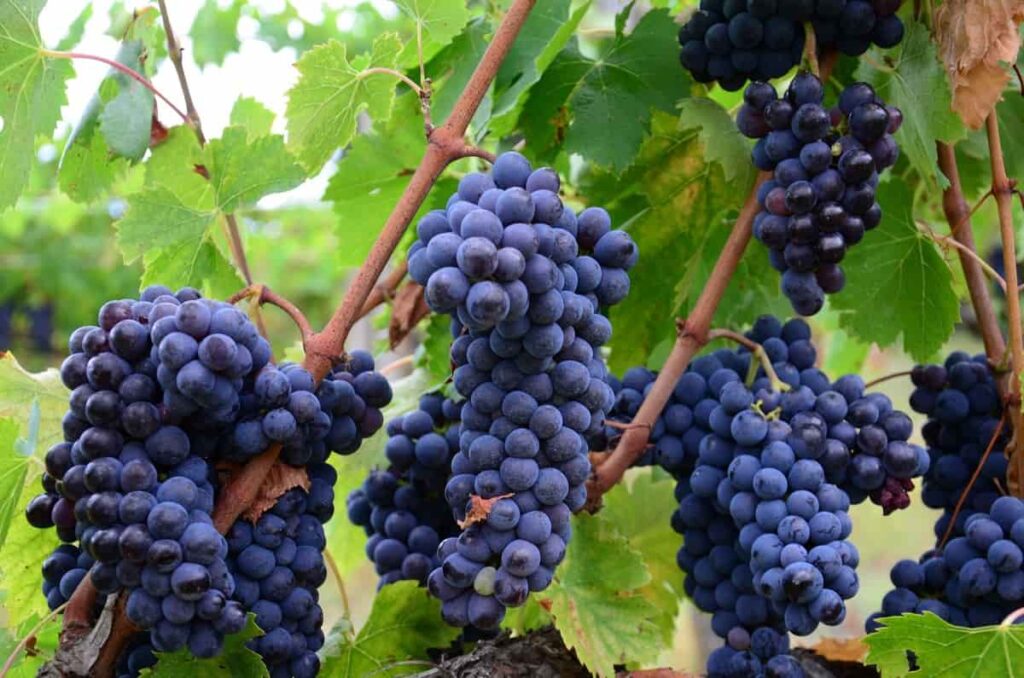
Anthracnose
Due to its appearance on the infected fruit, anthracnose is caused by Elsinoe ampelina fungus. It is also known as bird’s-eye rot. This disease is a severe threat across all Grape-producing regions of India. Continuous or intermittent rain and high humidity are some factors that promote the growth of the disease.
Disease symptoms
- Initially, the disease appears as dark red spots on the berries. Then, the spots become circular, hollow, and ashy-gray as they develop, and in the late stages, they are surrounded by a dark margin.
- The fungus also affects shoots, petioles, tendrils, leaf veins, and fruit stems. A large number of spots can sometimes be seen on the young shoots.
- These spots can unite and wrap around the stem, resulting in the death of the tips. Furthermore, spots on petioles and leaves cause them to curl or become distorted.
Control and chemical management
- Sanitation and canopy management inoculum can be reduced by removing all infected woody tissue in the early spring as part of regular pruning.
- An early application of lime sulfur to the vines before bud swell has been shown to reduce the initial spread of Grape anthracnose. In addition, fungicide sprays throughout the season can prevent rapid defoliation from outbreaks of this disease.
- Fungicides such as Mancozeb, Chlorothalonil, and Thiophanate-methyl effectively control this disease.
Bacterial leaf spot
It is one of the destructive diseases of Grapes. The young growing shoots are affected first, and the disease infects leaves, shoots, and berries. The symptoms appear as minute water-soaked spots on the leaf’s lower surface along the main and lateral veins. A temperature range of 25-30 ºC and relative humidity of 80-90% is favorable for the development of the disease.
Disease symptoms
- The young growing shoots are affected first. Then, the disease infects leaves, shoots, and berries. The symptoms appear as minute water-soaked spots on the lower surface of the leaf’s main and lateral veins.
- Later, these spots merge and form larger patches. Finally, brownish-black lesions are formed on the berries, which later become small and shriveled.
Chemical control and management
- Apply sulfur sprays or copper-based fungicides weekly at the first sign of disease to prevent its spread. These organic fungicides will not kill leaf spots but prevent the spores from germinating.
- Applying copper and pyrethrins containing powder dust is one-step control for many insect attacks and fungal problems. Cover the t the leaf’s tops and undersides with a thin, uniform film or dust for best results. Depending on foliage density, 10 oz will cover 625 sq ft. Repeat applications every 7-10 days, as needed
Downy mildew
Downy mildew is a significant disease of Grapes throughout the eastern United States. The fungus causes direct yield losses by rotting inflorescences, berries, clusters, and shoots. In addition, indirect losses can result from premature defoliation of vines due to foliar infections. This premature defoliation is a severe problem because it predisposes the vine to winter injury. A vineyard may take several years to recover after severe winter injury fully.
Disease symptoms
- The fungus is an obligate pathogen that can attack all the vine’s green parts.
- The symptoms of this disease are often confused with those of powdery mildew. Leaves that are infected develop pale yellow-green lesions that gradually turn brown. It is common for severely infected leaves to drop prematurely.
- Often, infected petioles, tendrils, and shoots curl, develop a shepherd’s crook, and eventually die.
- It is common for young berries to be covered in white fruiting structures caused by the fungus when they are first infected. Older, infected berries of white cultivars may turn dull gray-green, while those of black cultivars may turn pinkish-red.
Chemical control and management
- Protectant fungicides can help prevent plant contamination but must be appropriately sprayed on the underside of leaves.
- You can use copper-based fungicides, such as Bordeaux mixtures and dithiocarbamates. However, a post-infection fungicide must be applied as soon as symptoms are detected. Post-infection fungicides such as fosetyl-aluminum and phenylamides are commonly used.
In case you missed it: Cauliflower Pests, Diseases, And Control Methods
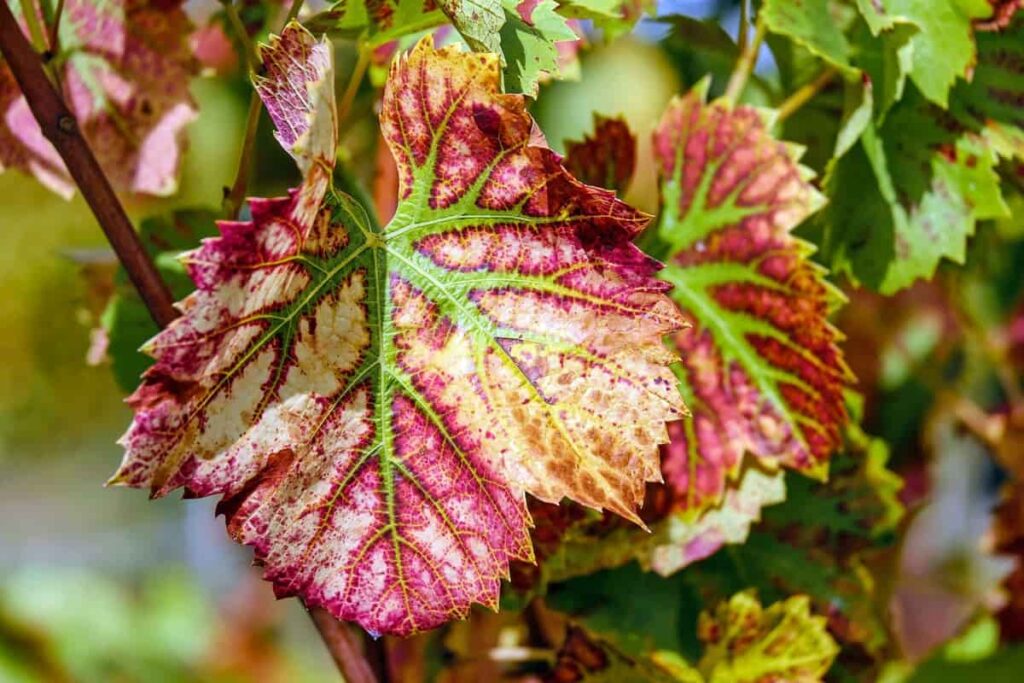
Black rot
The fungus Guignardia bidwellii causes black rot, one of the most damaging diseases of Grapes. A Grape’s leaves, shoots, berries, tendrils, rachises, and cluster stems (peduncles) can be infected with this fungus. Early treatment can prevent the disease from destroying Grape clusters, resulting in complete crop loss.
Disease symptoms
- The disease attacks the leaves, stems, flowers, and berries. In addition, all the new growth on the vines is prone to attack during the growing season.
- The symptoms are irregularly shaped reddish-brown spots on the leaves and a black scab on the berries.
- Occasionally, small elliptical dark-colored canker lesions occur on the young stems and tendrils. Leaf, cane, and tendril infection can occur only when the tissue is young, but berries can be infected until almost fully grown if an active fungicide residue is not present.
- The affected berries shrivel and become hard black mummies.
Chemical control and management
- Use protective fungicide sprays. Pesticides registered to protect the new growth include copper, ferbam, mancozeb, maneb, triadimefon, and ziram.
- Important spraying times are as new shoots are 2 to 4 inches long, and again when they are 10 to 15 inches long, just before bloom, just after bloom, and when the fruit has set.
Conclusion
Fungicide application strategies vary according to the pest or disease. Fungicides can be applied based on a schedule rather than observations made in the vineyard when minimal risk is desired. Several factors, such as the weather conditions, the vine’s stage of development, the Grape variety, and parasitic pressure, will determine whether fungicides should be sprayed.
- Types of Pesticides Used in Agriculture: A Beginner’s Guide
- Economical Aquaculture: A Guide to Low-Budget Fish Farming
- 15 Common Planting Errors That Can Doom Your Fruit Trees
- How to Make Houseplants Bushy: Effective Tips and Ideas
- Innovative Strategies for Boosting Coconut Pollination and Yield
- Pollination Strategies for Maximum Pumpkin Yield
- The Complete Guide to Chicken Fattening: Strategies for Maximum Growth
- Natural Solutions for Tulip Problems: 100% Effective Remedies for Leaf and Bulb-Related Issues
- Revolutionizing Citrus Preservation: Towards a Healthier, Greener Future
- Natural Solutions for Peony Leaf and Flower Problems: 100% Effective Remedies
- Maximizing Profits with Avocado Contract Farming in India: A Comprehensive Guide
- Natural Solutions for Hydrangea Problems: 100% Effective Remedies for Leaf and Flowers
- The Ultimate Guide to Choosing the Perfect Foliage Friend: Bringing Life Indoors
- From Sunlight to Sustainability: 15 Ways to Use Solar Technology in Agriculture
- The Ultimate Guide to Dong Tao Chicken: Exploring from History to Raising
- The Eco-Friendly Makeover: How to Convert Your Unused Swimming Pool into a Fish Pond
- Mastering the Art of Delaware Chicken Farming: Essentials for Healthy Backyard Flocks
- 20 Best Homemade Fertilizers for Money Plant: DIY Recipes and Application Methods
- How to Craft a Comprehensive Free-Range Chicken Farming Business Plan
- Brighten Your Flock: Raising Easter Egger Chickens for Beauty and Bounty
- How to Optimize Your Poultry Egg Farm Business Plan with These Strategies
- Subsidy for Spirulina Cultivation: How Indian Government Schemes Encouraging Spirulina Farmers
- Ultimate Guide to Raising Dominique Chickens: Breeding, Feeding, Egg-Production, and Care
- Mastering the Art of Raising Jersey Giant Chickens: Care, Feeding, and More
- Ultimate Guide to Raising Legbar Chickens: Breeding, Farming Practices, Diet, Egg-Production
- How to Raise Welsummer Chickens: A Comprehensive Guide for Beginners
- How to Protect Indoor Plants in Winter: A Comprehensive Guide
- Ultimate Guide to Grow Bag Gardening: Tips, Tricks, and Planting Ideas for Urban Gardeners
- Guide to Lotus Cultivation: How to Propagate, Plant, Grow, Care, Cost, and Profit
- Agriculture Drone Subsidy Scheme: Government Kisan Subsidy, License, and How to Apply Online
- Ultimate Guide to Raising Araucana Chickens: Breed Profile, Farming Economics, Diet, and Care
- Bringing Hydroponics to Classroom: Importance, Benefits of Learning for School Students
- Ultimate Guide to Raising Polish Chickens: Breed Profile, Farming Economics, Diet, and Care
- Ultimate Guide to Raising Australorp Chickens: Profile, Farming Economics, Egg Production, Diet, and Care
- Silkie Chicken Farming: Raising Practices, Varieties, Egg Production, Diet, and Care
- Sussex Chicken Farming: Raising Practices, Varieties, Egg Production, Diet and Care